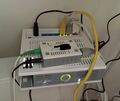A few weeks ago I've reported about my stellar speed experience with fiber connectivity in Paris with downlink and uplink speeds of 264 Mbit/s and 48 Mbit/s respectively. Today, I've got a follow up with a couple of pictures and technical background information.
Fiber and Copper in the Apartment
 Let's start at the end of the fiber. The first pictures shows two boxes stacked on top of each other. The bigger one below is a standard Wi-Fi access point with router functionality which is connected to the small box via an Ethernet cable. The small box is a fiber to copper converter. The green cable going into the small box is the fiber cable. The small box gets pretty warm so it's save to assume it takes more than the 2.5 Watts of a Raspberry Pi…
Let's start at the end of the fiber. The first pictures shows two boxes stacked on top of each other. The bigger one below is a standard Wi-Fi access point with router functionality which is connected to the small box via an Ethernet cable. The small box is a fiber to copper converter. The green cable going into the small box is the fiber cable. The small box gets pretty warm so it's save to assume it takes more than the 2.5 Watts of a Raspberry Pi…
 The second picture is a close-up of the of the fiber to copper converter, the Optical Network Terminal (ONT). The Ethernet cable on the left is connected to the bigger Wi-Fi network box shown in the first picture. The optical cable with the green connector on the right goes to the next box in the apartment shown in picture 3. As no power is delivered to this box it must be a passive component that connects the more sturdy optical cable coming into the apartment to the more flexible optical cable with the green connectors.
The second picture is a close-up of the of the fiber to copper converter, the Optical Network Terminal (ONT). The Ethernet cable on the left is connected to the bigger Wi-Fi network box shown in the first picture. The optical cable with the green connector on the right goes to the next box in the apartment shown in picture 3. As no power is delivered to this box it must be a passive component that connects the more sturdy optical cable coming into the apartment to the more flexible optical cable with the green connectors.
 And that's it as far as the equipment in the apartment is concerned. The fourth picture shows how the optical cable gets into the apartment via a crudely drilled hole that was filled with some glue afterward. Not quite a work of art to say the least.
And that's it as far as the equipment in the apartment is concerned. The fourth picture shows how the optical cable gets into the apartment via a crudely drilled hole that was filled with some glue afterward. Not quite a work of art to say the least.
Yes, it's GPON!
 So what kind of fiber technology is used for this line? The model number on the fiber to copper converter on picture 2 (I-010G-Q) gives the first clue that Google translates into a number of interesting links to follow. The most interesting one is to lafibre.info which contains lots of pictures of how the outdoor part of fiber networks are installed in France. The Google search for the model number also led me to a pretty interesting document from Alcatel Lucent which details their Gigabit Passive Optical Network (GPON) components and network setups on 250+ pages. So there we go, the I-010G-Q is part of a GPON installation. 2.4 Gbit/s in the downlink and 1.2 Gbit/s in the uplink direction that is shared between all installations behind one fiber strand that is split close to an apartment building into separate strands, one for each customer.
So what kind of fiber technology is used for this line? The model number on the fiber to copper converter on picture 2 (I-010G-Q) gives the first clue that Google translates into a number of interesting links to follow. The most interesting one is to lafibre.info which contains lots of pictures of how the outdoor part of fiber networks are installed in France. The Google search for the model number also led me to a pretty interesting document from Alcatel Lucent which details their Gigabit Passive Optical Network (GPON) components and network setups on 250+ pages. So there we go, the I-010G-Q is part of a GPON installation. 2.4 Gbit/s in the downlink and 1.2 Gbit/s in the uplink direction that is shared between all installations behind one fiber strand that is split close to an apartment building into separate strands, one for each customer.
From an evolution point of view the document's 2010 creation date is also interesting. In other words GPON is well in it's 4th year of deployment now and has come nowhere near capacity issues so far. And it's unlikely to happen anytime soon, i.e. there's no immediate need to beef up the specs to make it even faster. The challenge with GPON rather is, that optical cables need to go into buildings and from there to apartments to deliver speeds in the Gbit/s range. And that certainly comes at a price.
Great speeds!!! this is awesome.
would be nice if the physical layout were more neat and elegant. But maybe at those speeds no one cares 🙂
The boxes in your pictures are what I have at home in Paris. I usually have almost 300Mbits/s and 50Mbit/s, which seems to be the limit set by the operator (while they only advertise “up to 1Gbit/s”)
Hi David,
yes, reality and advertisement doesnt seem to be the same thing. I guess what they mean is the 1 Gbit/s speed of the Ethernet port rather than what their throttling allows 🙂
-Martin